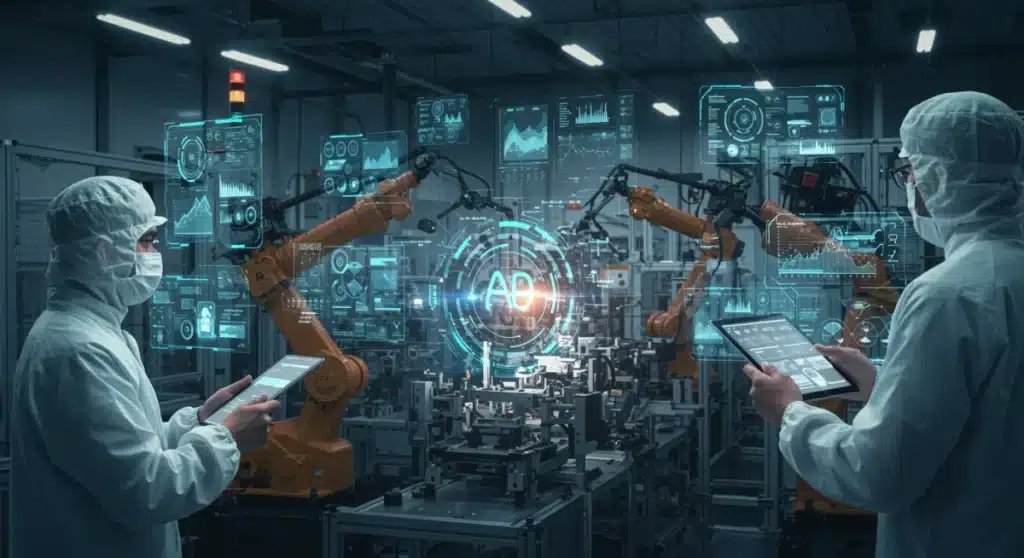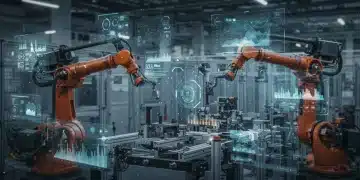AI-Enhanced Product Development: Accelerating Time-to-Market by 15% for US Innovators in 2025

AI-enhanced product development is accelerating time-to-market by 15% for US innovators in 2025, leveraging advanced algorithms for design, testing, and optimization, thereby transforming industrial processes and competitive landscapes.
The landscape of innovation is rapidly evolving, with artificial intelligence now at the forefront of transforming how products are conceived, designed, and brought to market. Recent developments indicate that AI-Enhanced Product Development: Accelerating Time-to-Market by 15% for US Innovators in 2025 is not just a projection but a current reality shaping the future of industries across the United States.
The Dawn of AI in Product Conception
Artificial intelligence is fundamentally reshaping the initial phases of product development, from ideation to concept generation. This integration allows companies to analyze vast datasets, identifying market gaps and consumer needs with unprecedented precision. AI tools are now capable of generating innovative product concepts that might otherwise take human teams months to devise, pushing the boundaries of what’s possible.
This shift is not merely about automation; it’s about intelligence augmentation. AI algorithms can sift through millions of patents, research papers, and customer feedback logs in minutes. This rapid analysis helps innovators pinpoint emerging trends and potential pitfalls before significant resources are committed.
Predictive Analytics for Market Needs
Predictive analytics, powered by AI, is becoming indispensable. It forecasts market demand, anticipates consumer behavior shifts, and even predicts the success rate of new products. This data-driven foresight minimizes risks and optimizes resource allocation.
- Demand Forecasting: AI models analyze historical sales data, social media trends, and economic indicators to predict future product demand, ensuring optimal production levels.
- Consumer Sentiment Analysis: Natural Language Processing (NLP) tools extract insights from customer reviews and social media, revealing unmet needs and preferences that inform new product features.
- Competitive Landscape Mapping: AI scans competitor offerings and market strategies, identifying opportunities for differentiation and competitive advantage.
Accelerating Design and Prototyping with AI
Once a concept is solidified, AI significantly speeds up the design and prototyping stages. Generative design, a key AI application, allows engineers to input design parameters and constraints, with AI then exploring thousands of design permutations. This process far surpasses traditional human-led design iterations in both speed and scope.
The ability of AI to simulate real-world conditions during the design phase means fewer physical prototypes are needed. This not only saves material and labor costs but drastically cuts down the time from initial sketch to functional model. Digital twins, virtual replicas of physical products, are also playing a crucial role here, enabling continuous testing and refinement.
Generative Design: A Paradigm Shift
Generative design tools are not just optimizing existing designs; they are creating entirely new structures and forms that are lighter, stronger, and more efficient. This capability is particularly impactful in industries like aerospace, automotive, and medical devices.
- Optimized Structures: AI designs components with ideal strength-to-weight ratios, reducing material usage and improving performance.
- Rapid Iteration: Multiple design options are generated and evaluated simultaneously, allowing for quicker selection and refinement of the best solutions.
- Material Efficiency: Designs are optimized for specific manufacturing processes and materials, minimizing waste and improving sustainability.
AI-Driven Testing and Validation Efficiencies
The rigorous process of testing and validation, traditionally a bottleneck in product development, is seeing massive efficiency gains through AI. AI-powered simulations can conduct virtual tests at speeds impossible for physical testing, identifying flaws and areas for improvement much earlier in the cycle. This reduces the need for expensive and time-consuming physical tests.
Machine learning algorithms analyze vast amounts of test data, both simulated and physical, to predict potential failure points and suggest design modifications. This proactive approach to quality assurance ensures products are robust and reliable before they even reach the manufacturing floor, significantly reducing recalls and warranty claims.

Automated Quality Assurance
AI is transforming quality assurance by automating inspection processes and predictive maintenance. This ensures higher product quality and reduces the likelihood of defects reaching the consumer.
- Defect Detection: Computer vision systems, trained on large datasets of product images, can identify microscopic flaws and inconsistencies with high accuracy.
- Predictive Maintenance: AI monitors performance data from prototypes and early production units to predict component failures, allowing for preventative adjustments.
- Compliance Verification: AI tools can automatically check designs against regulatory standards, ensuring compliance from the outset and avoiding costly rework.
Optimizing Manufacturing and Supply Chains
Beyond design and testing, AI’s impact extends into manufacturing and supply chain management, further contributing to accelerated time-to-market. Smart factories, powered by AI, use real-time data to optimize production schedules, manage inventory, and predict equipment failures, ensuring smooth and efficient operations.
Supply chain inefficiencies, often a major cause of delays, are mitigated by AI’s ability to forecast demand, optimize logistics routes, and identify potential disruptions before they occur. This end-to-end optimization ensures that raw materials are available when needed and finished products reach consumers without unnecessary delays.
Smart Factory Implementation
The adoption of AI in manufacturing processes leads to increased productivity and reduced operational costs. This makes production lines more agile and responsive to market changes.
- Production Scheduling: AI algorithms optimize production flows, minimizing bottlenecks and maximizing throughput.
- Inventory Management: Predictive analytics ensure optimal stock levels, reducing carrying costs and preventing stockouts.
- Robotics and Automation: AI-driven robots perform complex tasks with precision and speed, enhancing manufacturing efficiency and safety.
The Competitive Edge for US Innovators
The acceleration of time-to-market by 15% in 2025 represents a significant competitive advantage for US innovators. In a globalized market where speed often dictates success, being able to launch products faster allows companies to capture market share, establish brand loyalty, and outmaneuver competitors. This efficiency translates directly into increased revenue and sustained growth.
Early market entry also provides invaluable feedback cycles, enabling companies to iterate and improve their products more rapidly. This continuous innovation loop, fueled by AI, creates a virtuous cycle of improvement and market dominance. US innovators are leveraging this technology to maintain their leadership position on the global stage.
Market Dominance Through Speed
The ability to quickly respond to market demands and introduce cutting-edge products is critical for maintaining a competitive edge. AI provides the tools to achieve this speed without compromising quality.
- First-Mover Advantage: Launching products ahead of competitors allows companies to define market standards and capture early adopters.
- Enhanced Brand Reputation: Consistently delivering innovative products quickly builds a reputation for leadership and reliability.
- Increased Revenue Streams: Shorter product cycles mean new revenue opportunities arise more frequently, boosting financial performance.
Challenges and the Path Forward
Despite the immense benefits, the widespread adoption of AI in product development faces challenges. These include the high initial investment in AI infrastructure, the need for specialized skills, and ethical considerations surrounding data privacy and algorithmic bias. Addressing these challenges is crucial for realizing the full potential of AI-enhanced product development.
Companies are investing heavily in training their workforce, developing robust AI governance frameworks, and collaborating with AI experts to navigate these complexities. The path forward involves a strategic blend of technological adoption, talent development, and ethical oversight to ensure that AI serves as a force for positive innovation.
Overcoming Implementation Hurdles
Successfully integrating AI requires more than just technology; it demands a holistic approach that includes people, processes, and ethical guidelines.
- Talent Gap: A shortage of AI specialists and data scientists necessitates investment in upskilling existing employees and attracting new talent.
- Data Governance: Establishing clear policies for data collection, storage, and usage is essential to ensure privacy and prevent bias.
- Integration Complexity: Integrating AI tools with existing legacy systems can be challenging, requiring careful planning and execution.
| Key Aspect | Brief Description |
|---|---|
| Time-to-Market Acceleration | AI integration aims for a 15% reduction in product launch timelines for US innovators by 2025. |
| AI in Design & Prototyping | Generative design and virtual simulations streamline concept to functional model stages. |
| Manufacturing Optimization | AI-powered smart factories enhance production, inventory, and supply chain efficiencies. |
| Competitive Advantage | Faster launches allow US innovators to capture market share and foster continuous innovation. |
Frequently Asked Questions About AI in Product Development
AI-enhanced product development involves integrating artificial intelligence tools and methodologies across all stages of product creation. This includes ideation, design, prototyping, testing, manufacturing, and supply chain management to improve efficiency, reduce costs, and accelerate market entry.
AI accelerates time-to-market by automating repetitive tasks, optimizing design iterations with generative AI, conducting rapid virtual simulations for testing, and streamlining manufacturing processes through predictive analytics and smart factory operations. This collective efficiency reduces overall development cycles.
For US innovators, the primary benefits include gaining a significant competitive edge through faster product launches, improved product quality, reduced development costs, and the ability to respond more swiftly to evolving market demands and consumer preferences, driving sustained growth.
Yes, challenges include the substantial upfront investment in AI infrastructure, a shortage of skilled AI professionals, and complex ethical considerations related to data privacy, algorithmic bias, and job displacement. Overcoming these requires strategic planning and investment in talent.
Generative AI plays a crucial role by automatically generating numerous design options based on specified parameters and constraints. This capability allows engineers to explore a much wider range of innovative solutions, optimize designs for performance and material use, and significantly speed up the prototyping phase.
Looking Ahead
As of late 2024, the momentum behind AI-enhanced product development is undeniable. The projected 15% acceleration in time-to-market for US innovators by 2025 signals a transformative period. This shift is not merely about technological adoption; it represents a fundamental rethinking of how innovation occurs. Companies that strategically invest in AI, develop the necessary talent, and address ethical considerations will be the ones to define the next generation of products and secure a dominant position in an increasingly competitive global marketplace. The implications extend beyond individual companies, promising to reshape entire industries and elevate the standard of living through more efficient and innovative solutions.





